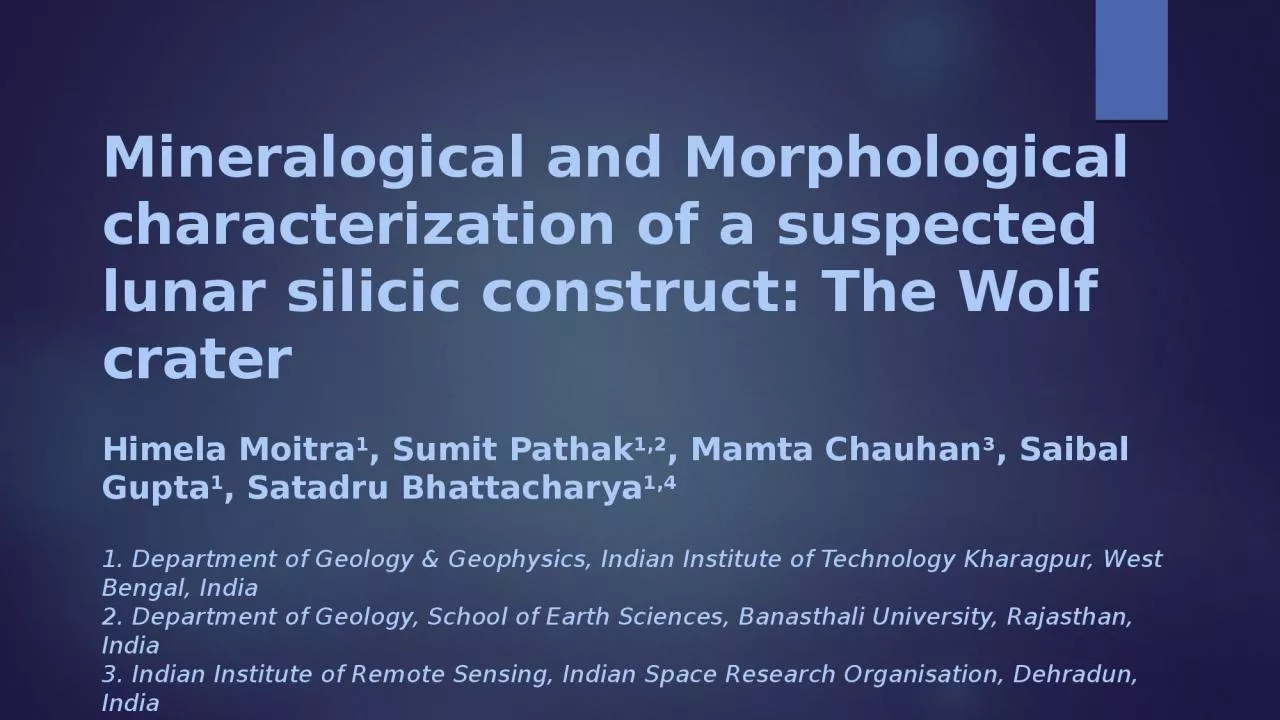

Himela Moitra 1 Sumit Pathak 12 Mamta Chauhan 3 Saibal Gupta 1 Satadru Bhattacharya 14 1 Department of Geology amp Geophysics Indian Institute of Technology Kharagpur West Bengal India ID: 1021192
Download Presentation The PPT/PDF document "Mineralogical and Morphological characte..." is the property of its rightful owner. Permission is granted to download and print the materials on this web site for personal, non-commercial use only, and to display it on your personal computer provided you do not modify the materials and that you retain all copyright notices contained in the materials. By downloading content from our website, you accept the terms of this agreement.
1. Mineralogical and Morphological characterization of a suspected lunar silicic construct: The Wolf craterHimela Moitra1, Sumit Pathak1,2, Mamta Chauhan3, Saibal Gupta1, Satadru Bhattacharya1,41. Department of Geology & Geophysics, Indian Institute of Technology Kharagpur, West Bengal, India2. Department of Geology, School of Earth Sciences, Banasthali University, Rajasthan, India3. Indian Institute of Remote Sensing, Indian Space Research Organisation, Dehradun, India4. Space Applications Centre, Indian Space Research Organisation, Ahmedabad, India
2. The Moon is mostly anorthosites and mare basalts, along with some other mafic rocks-a pretty simple mineralogical evolution, owing mostly to its low heat budget. Extensive differentiation of magma is not common. However, at certain regions, only six confirmed till now (shown in white boxes in the figure), evolved silicic compositions have been detected- in agreement with the very few felsic samples brought in by the Apollo missions. According to a recent study by Greenhagen et al. (2017), the Wolf crater is a prospective silicic construct. This work involves an investigation of the mineralogical composition of this ‘crater’, along with morphological studies, to understand the prospects of this crater being a silicic construct.
3. Wolf crater The largest crater in irregularly shaped crater complex- with an approximate diameter of about 25 km Situated within the central part of Mare Nubium in the southern hemisphere on the lunar near side (16.573°W, 22.904°S)Datasets used:LROC NAC, LROC WAC imagesVNIR dataset from Moon Mineralogy Mapper (M3) onboard Chandrayaan-1CF value map from LRO DivinerThorium abundance map from Lunar Prospector dataWolfWolf BWolf GWolf H10 km
4. A prospective silicic construct on the lunar surface:(i)Low CF value (ii)High Thorium abundance (iii)High albedo in certain areas(iv)Unusual shape for an impact crater, irregular crater floor mare-highland boundary10 kmGlobal silicate mineralogy map from CF values (Source: quickmap.lroc.asu.edu)20 kmThorium abundance map (Source: quickmap.lroc.asu.edu)
5. Mineralogy: VNIR spectra from M3
6. Pyroxenes have been detected in the VNIR spectra from the mare regions inside the crater complex (referred to as ‘crater floor basalt’) as well as in the mare regions surrounding the complex (referred to as ‘surrounding mare’). These mare pyroxenes are high-Ca pyroxenes as expected. Certain regions in the highland rim also show high-Ca pyroxene spectra. These are mostly located near to the mare basalts.Low Ca-pyroxene has also been detected in the highland rims of the crater complexSpinel has been detected in nearby mare region.Band-I versus Band-II center ratio plot using calculated mean B-I and B-IIcenter for the pyroxene spectra obtained from the highland rim, crater floor mare and the surrounding mare. These data are plotted along with Adams (1974) modified by Cloutis and Gaffey (1991a) and Klima et al. (2011a, 2011b) data for comparison
7. Conclusions:The Wolf crater is a prospective silicic construct. However, it is not entirely a silicic construct. Parts of this complex could be more evolved than highland anorthosite, showing the low CF values in certain regions. On the other hand, low-Ca pyroxene exposures suggestive of noritic-anorthosite mineralogies indicate that primitive highland compositions are still present. Such pyroxene exposures have not been detected in any of the other silicic constructs.The high-Ca pyroxene exposures on the rim are most possibly derived from the surrounding mare regions or from the crater floor mare, by subsequent cratering.The presence of low CF values in certain regions, knobby dome like features and high angle slopes retaining fresh rock fragments indicate toward possibilities of either partial remelting of certain parts of the original anorthositic rim, or exposure of a silicic intrusion by the impact event, as can be seen in the case of the Aristarchus crater.